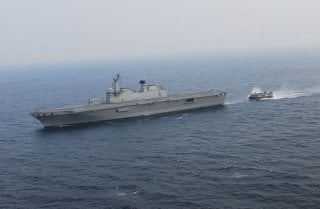South Korea Now Has a Second Mini-Aircraft Carrier
This new warship is also expected to serve as a “de facto” prototype that could contribute to the development of its light aircraft program.
Even as the government of the Republic of Korea determines the future of its aircraft carrier program, its navy commissioned its second and final Dokdo-class landing platform helicopter (LPH) amphibious assault ship. The flattop was designed by Hanjin Heavy Industries (HHIC), and can be utilized in amphibious assaults but also in military operations other than war (MOOTW), which can include disaster relief, promoting peace and supporting civil authorities in response to domestic crises. The warship had been launched in May 2018 and began sea trials last year.
The newly commissioned ROKS Marado is significantly smaller, with a light displacement of fourteen thousand tons or nineteen thousand tons full load displacement than the U.S. Navy's amphibious assault ships—notably the USS America (LHA-6), which at nearly forty-six thousand tons is larger than most nation's true aircraft carriers. However, the Dokdo-class LPHs are the largest warships currently in operation with the South Korean Navy reported Janes.
Marado, which features an improved design that came from experiences learned during operations with Dokdo, is 200 meters long, has a beam of 31 meters and a draft of 6.6 meters. The ship has a crew complement of just 330 sailors, but is also capable of carrying upwards of 720 marines, six main battle tanks, seven Korea Amphibious Assault Vehicles (KAAVs), a pair of Landing Craft Air Cushion (LCAC) vehicles and as many as a dozen helicopters. The flight deck is marked with five numbered landing spots on the port side, as well as two additional spots behind the island unit.
The newly commissioned warship also features a reinforced flight deck—with the material changed from high-tensile to ultrahigh-tensile steel—which can allow it to conduct operations with the U.S. Marine Corps’ MV-22 Osprey tilt-rotor aircraft. This could even allow the warship to serve as a base for rear support to the U.S. Marines, including fuel, ammunition and notably food, in the event of a conflict between the United States and China around Taiwan or near/on the Korean Peninsula.
According to Naval News, the new South Korean amphibious assault ship is armed with four KVLS cells that can launch a total of sixteen K-SAAM (surface-to-air missiles) Sea Bow, and two Phalanx Block 1Bs close-in weapon systems (CIWS). She is also equipped with a K-Dagaie NG decoy launching systems with new-generation decoys (SEALEM and SEALIR) by Lacroix. Key components and equipment for propellers and elevators have also been localized, while the warship was constructed with improved anti-air and flight systems.
The new warship is also expected to serve as a "de facto" prototype that could contribute to the development of its light aircraft program. Marado is now scheduled to be deployed at Jeju Naval Base, where it will serve as a command and control ship for the mobile fleet in charge of the South Korean Navy's overseas activities. It was also reported that Seoul has considered utilizing the vessel as a host ship to welcome the British Royal Navy's flagship aircraft carrier HMS Queen Elizabeth and her carrier strike group that is scheduled to visit the Republic of Korea Fleet Command in Busan in August.
Peter Suciu is a Michigan-based writer who has contributed to more than four dozen magazines, newspapers and websites. He regularly writes about military small arms, and is the author of several books on military headgear including A Gallery of Military Headdress, which is available on Amazon.com.
Image: Wikimedia Commons

